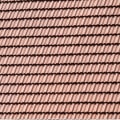Attic fans are typically installed near the peak of the roof to facilitate the expulsion of hot air and moisture from the attic space. The fan is strategically positioned to draw air out of the attic, creating a flow that helps regulate temperature and moisture levels. Additionally, Seacoast Roofing understands the importance of proper ventilation pathways. They can ensure that there is sufficient intake ventilation in the form of soffit vents or other openings to allow fresh air to enter the attic. This balanced ventilation system ensures the efficient operation of the attic fan, preventing heat buildup and moisture-related issues. By consulting with Seacoast Roofing, you can rely on their expertise to determine the ideal placement and setup of an attic fan tailored to your specific attic configuration and ventilation needs.
Ideally, you can install an attic fan in the ceiling between the rafters or the gable wall of your attic area. In addition, you can install attic fans in an existing vent, such as a vent box and an electric attic vent, so that's something to consider. The first step when installing a ceiling mounted attic fan is to determine where to place it. In general, you'll want to install the attic fan about 2 feet below the roof ridge.
It is estimated that good attic ventilation can lower the attic temperature by up to 25 degrees Fahrenheit. If you install the attic fan to one side or gable, ventilation will be greatly favored on one side only. To test the attic fan, you can simply attach a lamp to the thermostat so that it heats up and turns on the fan. You can adjust the temperature settings on the thermostat, which is the temperature you want the attic fan to turn on.
Installing the fan on a plywood mounting panel is a good idea because it keeps the fan blades away from the wall and allows you to center and secure the assembly without worrying about the underlying frame. Once you've lifted the shingles and cut off any nails that prevent installation, it's time to dry fit the attic fan. Locate the thermostat (small metal box) normally mounted on a beam or truss next to the fan in the attic. Installing an attic fan can help lower the temperature of your attic, saving you money in the long run.
Attach the fan mounting bracket to the plywood, center the fan over the opening, and screw the bracket to the plywood. If you can't find enough backup capacity on an existing circuit nearby, you'll need to go back to the service panel and create a new 15-amp circuit dedicated to the fan and perhaps some new attic lights. Before you rush out to buy an attic fan, take some time to check the existing ventilation in your home's attic. The fan has a five-year warranty, draws only 3.2 amps, and is capable of handling an attic area of up to 1500 square feet.
Attic fans can be a great way to lower the temperature of your attic and possibly extend the life of your roof covering. A fan equipped with a humidistat is a good option to control excess attic humidity during the colder months. Now draw the tiles around the stencil in pencil, so now you have a perfect outline of the attic fan.



